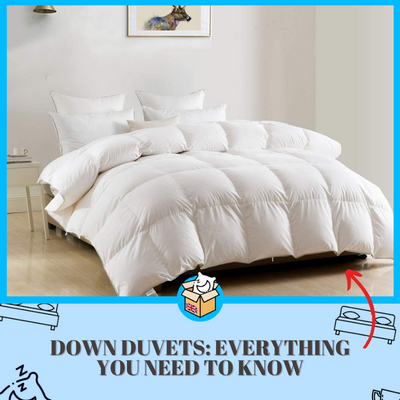We have the main points you should look for in a down duvet and if it’s the best choice for you. We cover a few FAQs in this article, but the first thing you may consider is the filling. Should you get goose or duck?

To help you decide, we go through these questions:
- How warm are down duvets?
- What size duvet do you need?
- Do down duvets help with allergies?
- How much do down duvets cost?
Let’s dive in.
Is goose down better than duck down?
Goose-down duvets are considered superior to duck-down duvets. Who would have thought buying a duvet would require so many considerations before jumping in?
Both goose and duck down fillers for duvets offer good insulation properties, but one comes out as the leader in weight and warmth, the goose.
Geese are bigger birds; hence they have bigger feathers and more down. Now, this may seem obvious, but there is a reason you need to know this,
The bigger the feather and down, the easier it is for air to become locked into the feathers and down. This will give superior insulation and thermal properties for warmth on cold nights.
Goose feather and down duvets are lighter because you need less fill for the same thermal efficiency.
That does not mean duck feathers and down duvets are bad. They are not, just heavier and more challenging to maintain. Plus, they can give off a slight odour!
How warm do you want the duvet to be?
This is a personal choice. Choosing the warmth of your down duvet will often correlate to the season, and you may decide you need more than one to see you through the year.
In the UK, the weather is unpredictable at any time of the year, so choosing the right tog should depend on the averages of warm, cool, and cold days. With one down duvet, you will find you only need one.
There is a choice and a tog rating for everyone. If you sleep cool, choose a higher tog and vice versa if you sleep hot.
Below is a table that represents how tog values could be used and how they may feel to you:
| SEASON | TOG RATING | FEEL |
| Summer | 2.5 tog or 4.5 tog | Lightweight |
| Spring & Autumn | 7 to 10.5 tog | Cosy in heated room |
| Winter | 12 to 13.5 tog | Very warm |
| All seasons | 4.5 tog + 9 tog | Choose your warmth |
What size down duvet do you need?
You need a duvet to fit your bed, with 5 common sizes of bed in the UK (not so much Emperor). You will find a suitable array of sizes designed specifically for your mattress size.
There would be an exception to this rule if you purchased your mattress from an international store that uses European and Scandinavian bed sizes.
Check out more in our duvet tog and size guide.
Duvet sizes:
| SINGLE | 140 X200cm | Ideal for a child or teenager’s bed, or twin guest beds. |
| DOUBLE | 200 X200cm | The perfect fit for a standard double bed. |
| KING | 225 X220cm | That is a little bit wider than a double, to perfectly fit your larger king-size bed. |
| SUPERKING | 260 X220cm | Generously wide to perfectly match the size of your super king bed. |
| EMPEROR | 290 X235cm | The largest duvet, specially designed for longer, wider emperor beds. |
Can you be allergic to goose-down duvet?
It is a rare state. If you wake up coughing and sneezing, it’s natural to point the finger of blame at your duvet if there are no external contributing factors such as pollen in the air.
But, the truth is it’s very rare for anyone to be allergic to goose feathers and goose down. The probable cause of the rise in allergies is the lack of maintenance of the duvet and the surrounding environment.
There was a study in 2019 that showed that bacteria and dust mite accumulation was caused by not cleaning the duvet every 6 months as recommended. You will not have any problems if you follow the manufacturer’s instructions.
What is the fill power of a duvet?
The fill power is a value of how fluffy your down duvets are. The fluffier, the better. It is correlated to the tog value. Fill power is also denoted as FP.
Apart from being soft and comfortable, plus inviting, the fluffy duvet plays an important role in how warm your duvet is. Being fluffy indicates there is a lot of air trapped inside the duvet. The air gives your duvet the warmth, not the down.
The fluffier the duvet, the less filling it has and needs to meet the tog value. Hence your duvet will be lightweight and warm.
Is Hungarian goose down hypoallergenic?
Yes. Known to be the superior feather and down the Hungarian goose is indeed hypoallergenic (just the down and feathers).
The superior feather does not stop at its anti-allergy characteristics. The feather is superior in other ways. It traps more air meaning your duvets are lighter and more breathable.
How much does the down duvet cost?
There is a wide variance in pricing. You may find it best and easier to buy online but don’t be surprised to pay anything from £250.00 to £1,500.00 + for a more expensive Hungarian duvet.
Buying a genuine article is expensive, but you must take a broader view before deciding what to buy.
Ok, let’s assume that your duvet is the most expensive illustrated here at £15,000. Spread over 365 days, your duvet costs you £4.11 per day. Not so bad, hey? But it gets better.
If your duvet has just a short life span of 5 years, it will cost you 8 pence per day. It’s a snip to have the very best on your bed.
Is a down duvet worth the expense?
It depends on where you are in your life. If you have kids sleeping in bed with you, which happens if you do, then maybe it’s not worth the investment.
If you are at a stage where you can enjoy the finer things in life, then a quality down quilt is a depreciating investment worth making.
 Nectar Mattress
Nectar Mattress 


